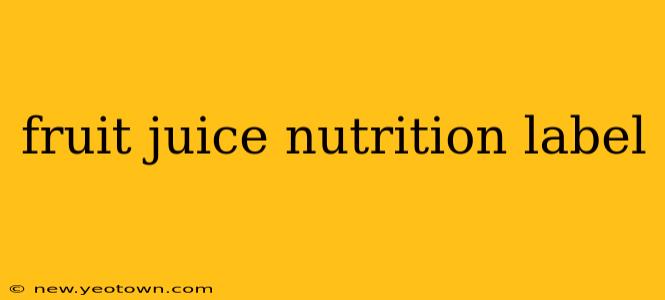Let's be honest, that brightly colored carton of fruit juice looks incredibly appealing. But before you grab it, there's a whole story hidden on that nutrition label – a story that can significantly impact your health. Navigating the information might seem daunting at first, but understanding what to look for empowers you to make informed choices. This isn't just about calories; it's about understanding the nutritional value (or lack thereof) of your fruity beverage.
What's the Deal with Serving Size on a Fruit Juice Nutrition Label?
The journey begins with the serving size. This seemingly small detail is crucial. Imagine a large carton boasting "only 100 calories per serving" – but a serving is only half a cup. That seemingly healthy choice becomes less so when you realize you're likely downing two or three servings in one go. Always check this number first, then calculate your total consumption based on how much you plan to drink. This is especially vital for those watching their calorie intake or managing blood sugar levels.
How Much Sugar is Really in Fruit Juice?
This is often the biggest surprise for many people. While fruit juice does contain some vitamins and minerals, it's shockingly high in sugar. Many juices contain as much, if not more, sugar than a soda. The label usually lists "Total Sugars" and sometimes breaks it down into "Added Sugars." Added sugars are sugars that weren't naturally present in the fruit itself, and they often contribute to empty calories without providing any additional nutritional benefits. Pay close attention to this number – the lower, the better. Look for juices with minimal or no added sugars.
What About Vitamins and Minerals in Fruit Juice?
Fruit juice does provide some vitamins and minerals, primarily vitamin C and potassium. However, the quantity can vary significantly depending on the type of fruit and the processing method. Whole fruits generally offer a more substantial nutrient profile, as the fiber remains intact. The fiber in whole fruit aids digestion and contributes to satiety, which helps manage weight. Juice often lacks this essential component. Check the label for the percentages of the Daily Value (%DV) for vitamins and minerals. A higher percentage indicates a more nutrient-rich beverage.
Does Fruit Juice Contain Fiber?
This is often a resounding "no." The process of juicing removes the pulp and fiber, which are crucial for digestive health and can help regulate blood sugar levels. The fiber is also what slows the absorption of sugar into the bloodstream, preventing that sugar rush and crash. So while juice might offer some vitamins and minerals, the lack of fiber significantly reduces its overall nutritional benefit.
Are There Different Types of Fruit Juices?
Yes, absolutely! The nutrition facts can vary greatly depending on whether the juice is 100% juice, a juice blend, or a juice drink. 100% juice typically contains only the juice from the fruit. Juice blends combine different fruit juices. Juice drinks, on the other hand, often contain added sugars, water, and other ingredients, significantly diluting the nutritional content. Always choose 100% juice, if possible, and always check the ingredient list to be sure.
How Can I Choose the Healthiest Fruit Juice?
The healthiest option often isn't fruit juice at all. Opt for whole fruits whenever possible! However, if you're looking for a juice option, look for those with no added sugars, high percentage of daily values for vitamins and minerals, and, ideally, some pulp (though this is less common). Prioritize 100% juice over juice drinks or blends with significant added sugar. Remember that moderation is key – even the healthiest juice should be consumed in limited quantities.
By carefully examining the nutrition label and considering these factors, you can make informed choices and enjoy your fruit juice in a way that aligns with your health goals. Remember, whole fruits are generally the superior choice for optimal nutrition, but understanding what's in your juice can help you make mindful decisions.

